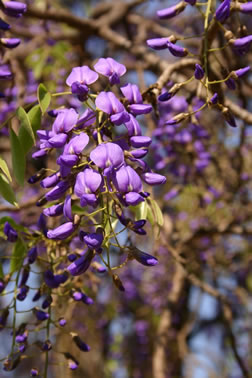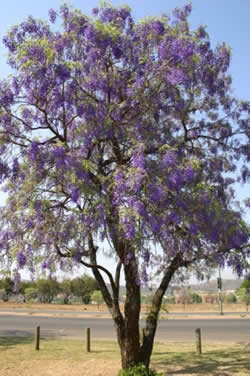 Bolusanthus speciosus Flowers. Picture courtesy www.lifeisagarden.co.za
Bolusanthus speciosus Flowers. Picture courtesy www.lifeisagarden.co.za![]() The tree wisteria occurs widely in Tropical East Africa from Malawi, Zambia, Zimbabwe, and south into north-eastern South Africa. It is widespread in wooded grasslands of the Northern Province, Mpumalanga, Swaziland and KwaZulu-Natal. This tree has been introduced elsewhere e.g. Kenya, Uganda, India and Australia. Bolusanthus speciosus is a protected tree in South Africa and wild specimens may not be removed, cut down or damaged in any way.
The tree wisteria occurs widely in Tropical East Africa from Malawi, Zambia, Zimbabwe, and south into north-eastern South Africa. It is widespread in wooded grasslands of the Northern Province, Mpumalanga, Swaziland and KwaZulu-Natal. This tree has been introduced elsewhere e.g. Kenya, Uganda, India and Australia. Bolusanthus speciosus is a protected tree in South Africa and wild specimens may not be removed, cut down or damaged in any way.
The tree wisteria is certainly one of the most spectacular of our indigenous trees, and when in bloom rivals even the splendour of the jacaranda (Jacaranda Mimosifolia), which unfortunately has been classified as an invader species in parts of South Africa. It is a wonderful substitute for the jacaranda, although it is smaller growing and more delicate looking. Its biggest drawback is that the flowers only last a few weeks. However, its graceful weeping habit and attractive glistening leaves make this an attractive tree all year round.
Striking fragrant, violet-blue (rarely white), pea-shaped flowers droop from the branches in huge bunches, often covering the entire tree in spring and early summer (August to January).The flowers are followed by narrow, flat, papery, light brown to blackish fruit pods (February to March). They persist on the tree for a long time after flowering, and never split open to release their seeds.
The tree wisteria is a small tree that is usually multi-stemmed, but can be trained to grow with a single stem. It has a narrow crown and wispy, weeping foliage. The rugged, dark bark is rough and becomes deeply vertically grooved in older trees. The straight growing stems are very hard and borer and termite resistant, and were used to make fencing posts. The heartwood is reddish-brown and often streaked. It is highly sought after by carpenters for making furniture. Although the wood is heavy and hard, and the pieces are small, it works well on a lathe, turning out beautiful household utensils, lampshades, bowls and other small items.
 Bolusanthus speciosus. Mature specimen. Picture courtesy www.lifeisagarden.co.zaBolusanthus speciosus is an ideal tree for a small to medium-sized gardens, as it never grows too big and it does not have an invasive root system. It also makes an excellent avenue or street tree. In larger gardens it can be grouped together to create a forest effect. This tree grows well in large pots on a sunny patio and makes an excellent bonsai specimen. The tree wisteria will attract butterflies to your garden, and in the wild animals like monkeys, sable antelope, gemsbok, giraffe and grey duiker eat the pods and leaves. In traditional medicine the roots are used to alleviate stomach problems and the inner bark is used to treat abdominal cramps.
Bolusanthus speciosus. Mature specimen. Picture courtesy www.lifeisagarden.co.zaBolusanthus speciosus is an ideal tree for a small to medium-sized gardens, as it never grows too big and it does not have an invasive root system. It also makes an excellent avenue or street tree. In larger gardens it can be grouped together to create a forest effect. This tree grows well in large pots on a sunny patio and makes an excellent bonsai specimen. The tree wisteria will attract butterflies to your garden, and in the wild animals like monkeys, sable antelope, gemsbok, giraffe and grey duiker eat the pods and leaves. In traditional medicine the roots are used to alleviate stomach problems and the inner bark is used to treat abdominal cramps.
The Tree Wisteria thrives in a variety of environments. It is ideal for summer rainfall areas, but it does not like cool wet summers. Plant it in full sun and in fertile soil that drains well. It is deciduous, dropping its leaves only for a short period in early spring. Once established, it can withstand long periods of drought and will tolerate moderate frost; young trees need regular watering and protection from frost, until they are established. In the wild this is a small, slow growing tree, varying in height from 6 to 12m tall. In the garden it generally grows 4 to 8m.


